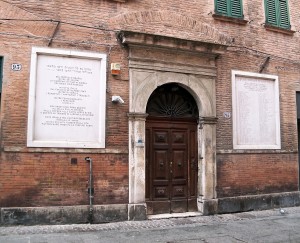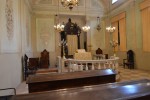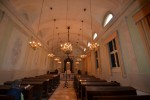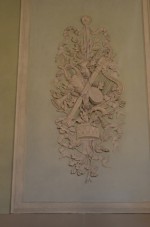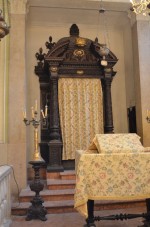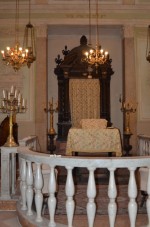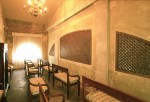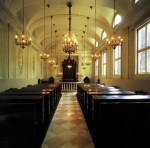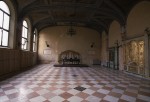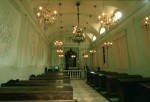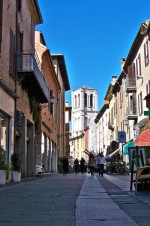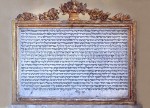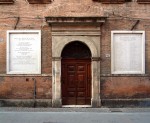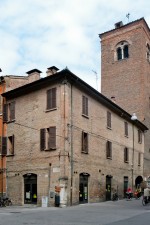Via Mazzini Complex
The Via Mazzini complex contains the history of the Jewish community of Ferrara. It is the only one in Italy that has seen the uninterrupted presence of a Jewish Community since the fifteenth century. It houses three synagogues, the Community offices and the Jewish Museum. It is currently closed for restoration due to the effects of the 2012 earthquake.
1. The building
Outside, the complex is distinguished from the other buildings only by the two plaques mounted after the Second World War in memory of the victims of the deportations. The typical bricks of the façades of many Ferrara houses hide a labyrinthine internal structure made of stairs and corridors, which reflects the population density of the Ghetto, while the harmonious combination of the different styles reflects the succession of successive extensions in the various eras.
The two floors of the building until the Second World War housed, unique in Italy, three synagogues: the Italian Temple, the German Rite Synagogue and the Fanese Oratory. The rabbinical court, the historical archive and the library were also located here.
As soon as you enter, you will find the rectangular courtyard, with two recently placed white marble columns that are used as supports for the traditional hut set up every year in the autumn for the festival of Sukkot (Huts). On the left wall and near the staircase you can see some almsgivers no longer in use: one is dated 1672, a second and a third 1656, another 1652 and the last 1741. On one of the back walls there is a red marble fountain, used for washing hands before entering the synagogue, dating back to 1593 and dedicated to Elisha Finzi.
2. From the origins to Ser Mele
The Jewish history of the building on Via Mazzini began when in 1407 Niccolò III granted the lender Angelo of the late Manuele da Rimini to buy two adjoining houses in the district of San Clemente on Via dei Sabbioni (now Via Mazzini). The premises not only had the function of a dwelling and pawn shop: inside there was also an oratory used by some Jews from Ferrara, who since the thirteenth century had obtained from the authorities the concession to exercise their rites.
The recognition of the oratory of Via dei Sabbioni as the synagogue of all the Jews of Ferrara, which thus differs from the washrooms and family oratories, is found in an act of the Office of the Inquisition of 1457
3. The legacy of Ser Mele and the expansions
It was Ser Mele of the late Salomone da Roma that ensured the stability of the synagogue and the other premises on Via Sabbioni. In October 1485, with a testamentary bequest, he donated the building, purchased four years earlier, with its contents to the Community, prohibiting any alienation, provided that a common place reserved for the rite continues to exist inside.
In the sixteenth century, in the seventies, the Italian synagogue was enlarged to its final size and in 1603 the German synagogue, which until then had been located in Via Gattamarcia (now Via della Vittoria), found a new location on the first floor. In the seventeenth century, the Fanese School was also built.
4. The Second World War and the Post-War
The centuries-old Jewish presence in the building of Via Mazzini was abruptly interrupted in 1944, when in the month of February the authorities of the Italian Social Republic ordered the seizure of the building and the Guardia di Finanza compiled an inventory of all its contents: it is the last description of that intact religious and cultural heritage. In September 1944, in fact, the Fascists looted and damaged the synagogues and other premises.
With the Liberation, survivors of persecution returned to the empty and devastated building. Fortunately, the German synagogue reopened, while the Italian synagogue was no longer used for worship, with the exception of a solemn commemoration in memory of the victims of persecution in the days of Kippur in 1945.
Only at the beginning of the 1990s, also thanks to state contributions, are important restoration and consolidation works undertaken that allow the recovery of the historical spaces pertaining to the offices of the Community, the so-called "lenders' room" or the assemblies and the historical archive
Bibliography
- Tedeschi Falco, Annamarcella, Ferrara. Guida alle sinagoghe e al museo, Marsilio, Venezia 2001
- Luoghi ebraici in Emilia Romagna, Touring Club Italiano, Milano-Bologna 2006
- Provasi, Matteo, Ferrara ebraica, 2G Editrice, Ferrara 2010
- Ravenna, Paolo, La sinagoga dei Sabbioni. Il Tempio di Rito Italiano a Ferrara da Ser Mele ai Finzi Contini, Edisai, Ferrara 2012
- Foa, Anna, Andare per ghetti e giudecche, Il Mulino, Bologna 2014 , pp. 91-100
- Bonilauri, Franco - Maugeri, Vincenza, Sinagoghe in Italia. Guida ai luoghi di culto e della tradizione ebraica, Mattioli 1885, Fidenza (Parma) 2014
- Comune di Ferrara, Comunità Ebraica di Ferrara, Ferrara. Il ghetto Vai al testo digitalizzato
Fototeca
Related places
Related Themes
Related Subjects
Related Itineraries
Compiling entity
- Istituto di Storia Contemporanea di Ferrara
Author
- Federica Pezzoli
- Sharon Reichel

